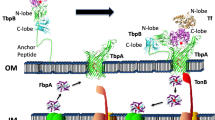Abstract
The effectiveness and mechanism of iron acquisition from transferrin or lactoferrin by Aeromonas hydrophila has been analyzed with regard to the pathogenesis of this microbe. The ability of A. hydrophila's siderophore, amonabactin, to remove iron from transferrin was evaluated with in vitro competition experiments. The kinetics of iron removal from the three molecular forms of ferric transferrin (diferric, N- and C-terminal monoferric) were investigated by separating each form by urea gel electrophoresis. The first direct determination of individual microscopic rates of iron removal from diferric transferrin is a result. A. hydrophila 495A2 was cultured in an iron-starved defined medium and the growth monitored. Addition of transferrin or lactoferrin promoted bacterial growth. Growth promotion was independent of the level of transferrin or lactoferrin iron saturation (between 30 and 100%), even when the protein was sequestered inside dialysis tubing. Siderophore production was also increased when transferrin or lactoferrin was enclosed in a dialysis tube. Cell yield and growth rate were identical in experiments where transferrin was present inside or outside the dialysis tube, indicating that binding of transferrin was not essential and that the siderophore plays a major role in iron uptake from transferrin. The rate of iron removal from diferric transferrin shows a hyperbolic dependence on amonabactin concentration. Surprisingly, amonabactin cannot remove iron from the more weakly binding N-terminal site of monoferric transferrin, while it is able to remove iron from the more strongly binding C-terminal site of monoferric transferrin. Iron from both sites is removed from diferric transferrin and it is the N-terminal site (which does not release iron in the monoferric protein) that releases iron more rapidly! It is apparent that there is a significant interaction of the two lobes of the protein with regard to the chelator access. Taken together, these results support an amonabactin-dependent mechanism for iron removal by A. hydrophila from transferrin and lactoferrin. The implications of these findings for an amonabactin-dependent mechanism for iron removal by A. hydrophila from transferrin and lactoferrin are discussed.
Similar content being viewed by others
Author information
Authors and Affiliations
Additional information
Received: 8 August 1999 / Accepted: 22 October 1999
Rights and permissions
About this article
Cite this article
Stintzi, A., Raymond, K. Amonabactin-mediated iron acquisition from transferrin and lactoferrin by Aeromonas hydrophila : direct measurement of individual microscopic rate constants. JBIC 5, 57–66 (2000). https://doi.org/10.1007/PL00010655
Issue Date:
DOI: https://doi.org/10.1007/PL00010655



